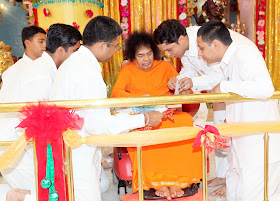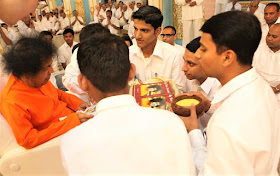At Shirdi, Mahalsapati, a priest in local temple saw Him entering the local temple. Looking at His appearance as a Muslim, Mahalsapati turned Him out of the temple. The boy went back and sat under a neem tree. He was only 16 years old at that time. No one knew then what His name was. If anyone asked His name, He would give no answer. He would sometimes retort saying, “Why do you want to know My name?” Because of this, nobody could find out His name.
 |
| Mhalasapati welcomes Sai Baba |
Some villagers from nearby places used to visit Him under the tree and get relief from their aliments. He would take out some leaves, crush them and give them to the ailing persons as a medicine. In this manner, He cured many a person of their illness. News of His healing powers spread all over the surrounding villages. As a result, a large number of people used to come to Him, receive the crushed leaves from Him and get cured of their ailments.
Suddenly, one morning He disappeared. A futile search was made in the nearby areas to trace Him. He had stayed in Shirdi for barely two months before setting about to wander from place to place. Later in 1858, He returned to Shirdi. There was a village called Dhoop in Aurangabad. A person by name Chandubhai Patel, belonging to a middle-class family, lived in Dhoop. As no other form of transport was available in those days, people used to go only on horseback.
Chandubhai went on his horse to Aurangabad on some urgent business. When he had finished his business there at the end of three days, he found that the horse was missing. Disappointed over the missing horse, Chandubhai was returning to Dhoop through dense forests on the way.
At one place, he saw a fakir sitting under a tree. The fakir appeared to be lost in His own thoughts. Suddenly, the fakir hailed Chandubhai with the words: “Hey, Patel! Come here”. The fakir liked to smoke Chilim (hookah). As there was no water nearby, the fakir hit the ground with a stick and water gushed forth from the place. He hit again another place with a stick and there was a fire. Using the water and the fire, He started smoking his hookah and offered it to Chandubhai also. Chandubhai declined the offer.
 |
| Shirdi Sai Baba with Chandubhai Patel (often referred to as Chandbhai Patil) |
The fakir asked Chandubhai, “What is worrying you Patel?” Patel asked, “How did you know I am Patel?” “I know everything,” replied the fakir. “You are worried about your horse. You are keeping your eyes on the top of your head! You must lower them to trace the horse. Your horse is gazing under the tree there”. Chandubhai saw his horse there. He had a search conducted for the horse in the same place with the help of some workers, but could not find it. But, now he saw it under a tree close to him. Chandubhai was astonished that the fakir had produced water and fire out of the earth and had located his missing horse. He appealed to the fakir, “Swami! You have rendered great help to me. Please come with me and share my hospitality”. “All right, let us go,” the fakir replied.
About this time, the marriage of Chandubhai’s niece, who was residing in Shirdi, was settled. Chandubhai had to go to Shirdi for the wedding. He requested the fakir to come along with them. They went in carts to Shirdi. Mahalsapati saw the fakir getting down from a cart, went to Him, and said, “Aayiye Baba! Aayiye Sai (Come Baba! Come Sai!)”. The name “Sai” was given by Mahalsapati. Till then, no one had conferred a name on Him.
Sometime later, Baba was accused in a criminal case. He had to give evidence in a case that related to the theft of some valuables from a rich man’s house by a gang of thieves. The police caught the thieves and questioned them about the stolen articles. The thieves said that the valuables had been given to them by a fakir. Searching for the fakir, they came to Baba. They asked Him, “Fakir, did you give these articles to them?” “Yes”, He said. “Where did you get them from?” was the next question. Baba replied, “They have come from the same place from which all things come”. Finally, they asked, “Who gave them to you?” “I gave them myself”. was His reply.
 |
| Sai Baba in the Dwarkamai |
Q: “What is Your religion?”
A: “The religion of God”.
Q: “Where do You come from?”
A: “I have come from the Atma”.
Q: “What is Your caste?”
A: “The caste of the Divine”.
Baba answered all the questions in this manner. Earlier He had been hailed as ‘SAI’. In His examination, He had given His father’s name as Baba. By the combination of these two names, He was therefore called “SAI BABA”. No one knew when and where Sai Baba was born and who gave Him that name. Baba, who came to Shirdi with Chandubhai Patel in 1858, did not leave the place until His passing in 1918. Baba lived for 80 years.
- “The Shirdi Sai Saga”, Sathya Sai Speaks, Volume 25, September 27, 1992, Prasanthi Nilayam
Many people used to have doubts about Baba’s transcendental powers. One day, the birth anniversary of Dattatreya was to be celebrated in the month of Margashirsha (ninth month of the Hindu calendar) on Panchami (fifth day of the lunar calendar). Several devotees had assembled in Shirdi. A great and wealthy scholar called Balwant Kaijack was among them. As he was approaching the Masjid, Baba took His stick and marked it at the devotees, asking them to get away. He even beat some of them, shouting, “Shaitan! Shaitan!” No one could understand why Baba was behaving like this. “I am suffering labour pains. Get away, all of you!” He shouted. In those days, Baba not only used to shout at people, but also wield the stick on them on occasions. He even used to throw the stick at fleeing persons. Everyone used to be afraid of Him. They all left the place.
Sometime later, He called all of them to come. “Balwant Kaijack, come!” He said. When Balwant came, Baba went inside the Masjid. Balmant went in and found that Baba was not there. He found a three-headed baby on the floor. Baba had declared that He was suffering from labour pains and there was a baby there. The three-headed child appeared to represent Dattatreya. It was a small baby with a number of hands. Balwant recognised the child as Dattatreya and called other devotees to come inside. They went in, and on seeing the child, closed their eyes. At that instant, Baba reappeared there. From that time onwards, people started looking upon Baba as the incarnation of Dattatreya.
A controversy arose among the local people as to whether Baba was a Muslim or a Hindu. At one time, He used to say: “Allah Malik! Allah Malik!” At other times, He would say, “Dattatreya Malik!” Whenever He shouted “Allah Malik!” Muslims used to come to Him in the Masjid. His appearance was very much like that of a Muslim. Hence, many Muslims used to come to Him. Hindus also used to come and offer incense to Him. The Muslims did not approve of what the Hindus were doing. The Hindus did not like the way Muslims revered Baba. Consequently, bitterness developed between the two communities.
One day, Mahalsapati was sitting near Baba and doing some service to Him. Mahalsapati was the priest in the Khandoba temple. The Muslims, who were opposed to the presence of a Hindu priest near Baba, came with sticks and beat up Mahalsapati. At every stroke, Mahalsapati cried out: “Baba! Baba!” Each time he shouted the name of Baba, the blow was borne by Baba. Mahalsapati fell to the ground. Baba came out. Muslims had great reverence for Baba. Baba roared at the Muslim crowd, “Shaitan! On one side, you worship Me and on the other, you beat Me. Is this your devotion?” Baba was bleeding all over the body. The Muslims saw it and asked Baba who had beaten Him? “Did you not beat Me?” said Baba pointing to several men in the crowd. They said, “We did not come near you at all. We only beat Mahalsapati”. “Who is in Mahalsapati? I am in him,” declared Baba. “He has surrendered to Me and hence all his troubles are Mine”. On hearing this, the Muslims fell at Baba’s feet and craved for His forgiveness. Baba then summoned the Hindus and Muslims and told them, “Dear children, you are all the progeny of one mother”. Thereby Baba demonstrated the fatherhood of God and the brotherhood of man. He wanted all differences of caste and creed to be eschewed. What mattered for mankind was the heart.
You must seek the Divine within you. Baba pointed out that all caste and creed distinctions are related only to the body. Therefore, you should seek the Supreme in your inner consciousness.
 |
| Sai Baba at Shirdi |
One day, a Pandit came to Baba and said that Baba’s biography should be written. His name was Hemadpant. He is the author of ‘Sai Satcharita’. He entreated Baba to disclose facts about the place of His birth, His parentage, His name and His early life. He could not get any information from anyone. Baba did not reveal anything to anyone. But, on one occasion, when He was alone with Mahalsapati, Baba disclosed His date of birth to him. Mahalsapati was no scholar. He had learnt only a few Mantras to conduct the Puja the temple. He noted down the date of birth on a piece of paper. This came into the hands of Hemadpant. With this, he began to write the life of Baba.
No one knows the real truth about Baba. The world knows some facts about His life only after His sixteenth year. He was born on September 28, 1835 and attained Samadhi on Vijaya Dashami day in 1918. During His lifetime, He taught many things to the people and performed many remarkable deeds. He was worshipped by many devotees. Dada, Nana, Shama, Abdul Baba, Mahalsapati, Chandorkar and Das Ganu were always with Him. Abdul Baba was active till recently. He was an ardent devotee of Baba. In his view, it did not matter to what religion one belonged. All were one in their devotion to God. Kaka Dixit was a judge whose son stayed in Brindavan (Whitefield) for twenty years. Kaka Dixit maintained a diary in which many facts about Baba have been recorded including His statement about when He would pass away.
- “The Shirdi Sai Saga”, Sathya Sai Speaks, Volume 25, September 27, 1992, Prasanthi Nilayam
























